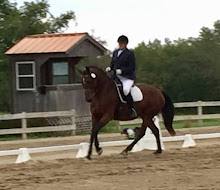Today three of the young horses were worked. Two mares and a gelding. Both of the mares are a little farther along than the gelding. Samantha Wagner rides our young horses and today we played with shoulder-In on all three of them. It was interesting to see the reactions of each horse based on their temperaments and their physical attributes.
When we teach young horses to walk, trot and canter and even leg yield, they can travel with the base of their legs in a wider fashion. Nature tells them if they keep their base wider that they are more physically stable. Before shoulder in is introduced, there must be a basic amount of trust from the horse towards the rider. This is because shoulder In narrows the base of the horse. A horse with a narrower base can start to collect and carry itself on its back end a little more. But a horse with a more narrow base must trust its rider at least somewhat. Because as the horse narrows its base and performs shoulder in, he or she is less physically stable side to side but is using their hind quarters better.
The first mare is a rather wide built mare that is strong but not laterally flexible. She is independent in her thoughts and a little opinionated. We started the shoulder in in the trot so she could feel the stretch but also have enough forward thrust that if she disagreed with her rider - she could still successfully be pushed forward so she could be rewarded.
The second mare was also a wide muscular horse that is a bit shy and timid. We introduced the shoulder in on this mare in the walk because if she gets stressed out she likes to slow things down and think about them. Then when the rider tries a second time she is likely to try harder. She did well in the walk and struggled a little in the trot. The struggle was not independent thinking but rather the result of a muscular horse that can stretch only so far the first day.
The gelding was the least trained but he is a TB/warmblood cross. So he has a narrower base to begin with. He is a confident young man so we started the shoulder In at the trot. He found his way there on the first try on both sides. The reason he had it easier was because of how he is put together.
If you are working with your horse and they have a blocky build, remember that lateral movements will be slower when you start teaching them but will help the quality of the horses movement. Many horses are strong but not flexible, if this describes your horse lateral movements will help loosen them. Others are flexible but not strong. Weirdly, lateral movements also help them. The act of using their hind quarters more using shoulder in improves their strength.
Subscribe to:
Post Comments (Atom)

No comments:
Post a Comment
Note: Only a member of this blog may post a comment.